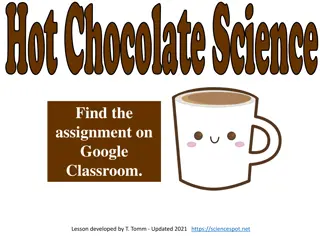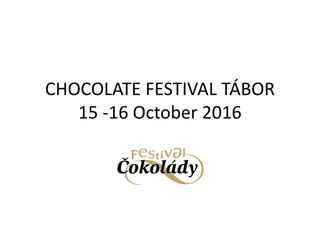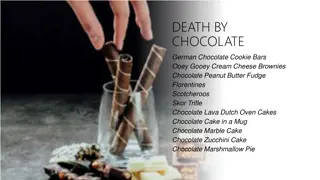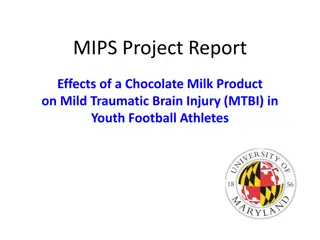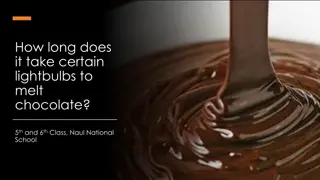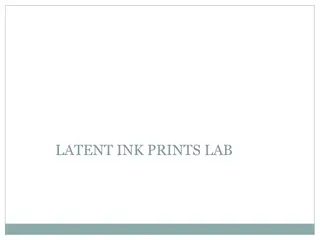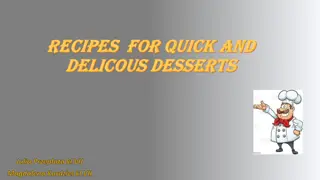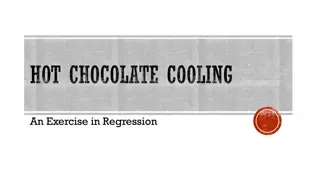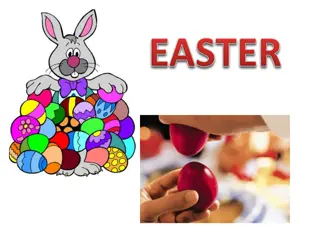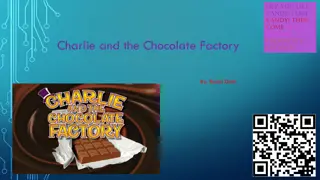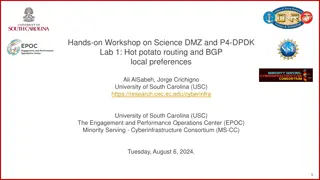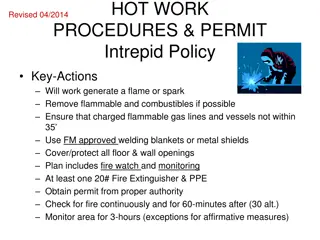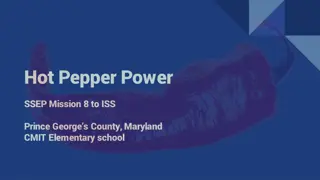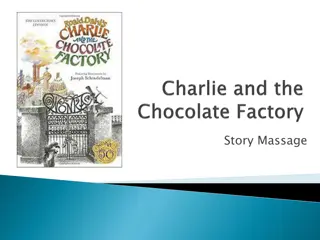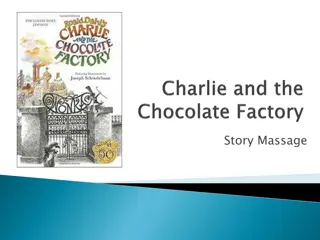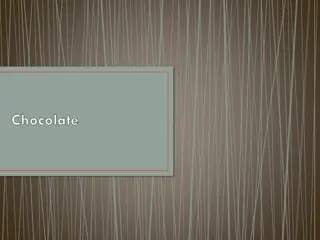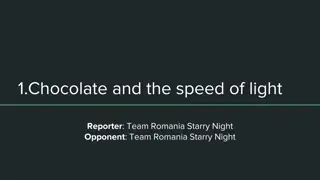Exploring Hot Chocolate Science Lab Assignment
Dive into the Hot Chocolate Science Lab Assignment developed by T. Tomm, updated in 2021. This engaging lesson explores states of matter, physical and chemical changes, and more. Get hands-on with cocoa science, marshmallow science, and the Hot Chocolate Effect while understanding concepts in chemistry. Utilize the provided resources and digital assignments to enhance your learning experience in a fun and interactive way.
Download Presentation

Please find below an Image/Link to download the presentation.
The content on the website is provided AS IS for your information and personal use only. It may not be sold, licensed, or shared on other websites without obtaining consent from the author. Download presentation by click this link. If you encounter any issues during the download, it is possible that the publisher has removed the file from their server.
E N D
Presentation Transcript
Hot Chocolate Science Find the assignment on Google Classroom. Lesson developed by T. Tomm - Updated 2021 https://sciencespot.net
Teacher Notes: This lab was developed to explore states of matter as well as physical and chemical changes, which are concepts we ve studied during our first unit in Chemistry unit. It will also be used during the second unit as we discuss classification of matter (elements, compounds, and mixtures), chemical bonding, and chemical reactions. I borrowed the larger percolator from our school cafeteria. The school also provided cups and spoons. I purchased Swiss Miss mix with marshmallows, which were available with larger packets (33% more powder). Since we had completed the Boyle s Law marshmallow lab the previous week, I used the leftover marshmallows so students were able to get a good cream on the top (if they waited long enough for them to melt). Students had time to work with their table mates to complete the last slide. They had time the following week to share what they had learned. NOTE: Viewing the presentation in edit mode will allow you to see any notes I ve added in the margin area to the left and right of each slide. Digital assignment for students available at https://docs.google.com/presentation/d/1X6pOA_9SLZ3yYn-lE7zpiyh7ucfdUFYJa95CTU9R1- U/edit?usp=sharing
Time to make some hot cocoa 1st Open the packet and dump the contents into the cup. 2nd When it is your turn, take your cup to the side counter and add water to fill the cup of the way up. Follow the leader around the room to stay spread out! 3rd Use your spoon to stir the cocoa to help it dissolve as you wait in line. 4th Return to the side counter and add enough water to get to fill it almost up. 5th Continue stirring until all of it is dissolved. 6th Get 10 marshmallows to add to the cocoa. 7th Let it cool down a little bit and then enjoy!
Hot Chocolate Science A red square with a white letter on it Description automatically generated with low confidence Part A: Cocoa Science 1. What causes the powder to clump? Why? Starch molecules attract water around dry powder. Puff up Mesh together to form a seal Dissolve the powder in a smaller amount of water before adding more water. 2. How do you avoid lumps? 3. What is the difference between hydrophilic and hydrophobic? Give an example of each. Loves water Starch Hates water Fats Casein 4. What protein in milk acts as an emulsifier in hot cocoa? 5. What does the term viscosity mean? How does it relate to hot chocolate? Viscosity refers to a liquid s ability to flow. Thicker hot chocolate has a higher viscosity than thinner ones.
A red square with a white letter on it Description automatically generated with low confidence Part B: Marshmallow Science Air 1. What is the key ingredient for pillowy puffy marshmallows? 2. What are the other ingredients in marshmallows? Sugar, corn syrup, water, cornstarch, and gelatin 3. Which ingredient gives it the elastic, squishy texture? What protein does it contain? Gelatin Collagen 4. What do we call the ingredients that helps to hold its shape? Emulsifiers A red square with a white letter on it Description automatically generated with low confidence Part C: Hot Chocolate Effect Air bubbles 1. What causes the Allassonic effect in a cup of hot chocolate? 2. Why does it happen? More bubbles Less bubbles Slower frequency (waves) Faster frequency (water) Lower pitch Higher pitch
Part C: Quick Review 1. What happens to the kinetic energy as each substance changes: increase or decrease? A. Steam rises from the surface B. Sugar is melted to make marshmallows C. Melted chocolate becomes solid chocolate OR D. Hot cocoa cools to room temperature E. Marshmallows melt in the hot water F. Putting hot chocolate in the freezer 2. What type of change is occurring in each example: P = Physical or C = Chemical? C C P P P P P P P P P P P P C C A. Hydrogen and oxygen combine to form water molecules B. Water is heated up until it turns to steam C. Mixing cocoa powder, sugar, and other ingredients to make the dry mix C C P P D. Ripping open the powder packet OR E. Powder dissolving in the water F. Marshmallows melting in the solution G. Stirring the hot chocolate Make your own marshmallows https://www.youtube.com/watch/fPXJ1uobO_0 H. Drinking the hot chocolate
Part D: Questions Brainstorm with your table group to develop 5 questions about this activity. Use online resources to help you answer the questions. Be prepared to share your results with the class.
Student Masters Student Masters The following slides were used to make PNG files for the digital assignment on Google Slides. If you would like to edit the student assignment, make changes to the following slides. Choose the save the file as PNG and follow the prompts. The images can be added as backgrounds for the Google Slides in the assignment. I added textboxes and other interactive features the students would need to complete the activity. The digital assignment is available at https://docs.google.com/presentation/d/1X6pOA_9SLZ 3yYn-lE7zpiyh7ucfdUFYJa95CTU9R1-U/copy
Hot Chocolate Science A red square with a white letter on it Description automatically generated with low confidence Part A: Cocoa Science 1. What causes the powder to clump? Why? 2. How do you avoid lumps? 3. What is the difference between hydrophilic and hydrophobic? Give an example of each. 4. What protein in milk acts as an emulsifier in hot cocoa? 5. What does the term viscosity mean? How does it relate to hot chocolate?
A red square with a white letter on it Description automatically generated with low confidence Part B: Marshmallow Science 1. What is the key ingredient for pillowy puffy marshmallows? 2. What are the other ingredients in marshmallows? 3. Which ingredient gives it the elastic, squishy texture? What protein does it contain? 4. What do we call the ingredients that helps to hold its shape? A red square with a white letter on it Description automatically generated with low confidence Part C: Hot Chocolate Effect 1. What causes the Allassonic effect in a cup of hot chocolate? 2. Why does it happen?
Part C: Quick Review 1. What happens to the kinetic energy as each substance changes: increase or decrease? A. Steam rises from the surface B. Sugar is melted to make marshmallows C. Melted chocolate becomes solid chocolate OR D. Hot cocoa cools to room temperature E. Marshmallows melt in the hot water F. Putting hot chocolate in the freezer 2. What type of change is occurring in each example: P = Physical or C = Chemical? A. Hydrogen and oxygen combine to form water molecules B. Water is heated up until it turns to steam C. Mixing cocoa powder, sugar, and other ingredients to make the dry mix C C P P D. Ripping open the powder packet E. Powder dissolving in the water OR F. Marshmallows melting in the solution G. Stirring the hot chocolate H. Drinking the hot chocolate
Part D: Questions Brainstorm with your table group to develop 5 questions about this activity. Use online resources to help you answer the questions. Be prepared to share your results with the class.


